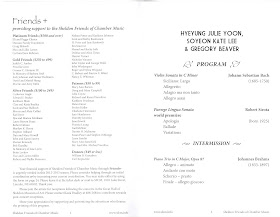The Sheldon Friends of Chamber Music in Lincoln, NE presented a program featuring Hyeyung Julie Yoon, Soyeon Kate Lee and Gregory Beaver. The concert was held in the auditorium of the Philip Johnson-designed Sheldon Memorial Art Gallery on the University of Nebraska-Lincoln Campus. Thanks to all of the benefactors who helped underwrite the cost of this performance.
For video excerpts, click on http://www.youtube.com/watch?v=LJnXmUsOnKM&feature=plcp
Ms. Yoon is the second violinist of the Chiara Quartet and
is artist-in-residence at UNL. Ms. Lee
is the first prize will of the 2010 Naumberg International Piano Competition. Mr. Beaver is the cellist for the Chiara
String Quartet and is also an artist-in-residence at UNL.
The Bach Sonata for Violin and Piano has a slow-fast-low-fast
structure. The program notes supplied
indicated that the “text is made particularly clear by the inclusion of a cello
which doubles the left hand of the piano” except there was no cello! The stage placement of the two players made
it impossible for the two musicians to actually see each other. Maybe they have played the piece so much that
visual cues were not necessary, but is reminded me of two children involved in
parallel play- they are both playing but not interacting. Ms. Yoon played with a broad vibrato that
seemed to detract from the precision of her playing and it led to some
intonation problems. Her instrument,
identified as a Roman violin from 1790 made by Giulio Ceare Gigli, does not
have a particularly warm sound so maybe she was attempting to compensate. The final section, Allego assai, has some
treacherously fast passages that challenge any players’ skills, and so it also
did for Ms. Yoon. Ms. Lee played with
great skill and authenticity. She was
idiomatic and is technically gifted.
Robert Sirota’s “Pange Lingua” was given it world premiere
at this concert. Mr. Sirota gave the
pre-concert lecture also. He is a
charming and gifted educator who manages to entertain and teach at the same
time. This work was commissioned by Ms. Yoon
in memory of her grandfather. The work
is based on a medieval hymn celebrating the Holy Eucharist. The work is in three parts- Apologia, Ballade
and Variations. The piece moves from the
aggressive to the reflective. The first movement
is at times strident and at times “in-your-face.” The second movement is more
lyrical, with some passages that are a bit Debussy like. The
first two movements present fragments of the theme from the hymn and only in
the last movement is the theme fully presented. Ms. Yoon and Ms. Lee played
admirably. Mr. Sirota’s work is not just a retelling of
the tale, it is a creative take on it, and is worth repeated hearing.
Brahms’ music is uniformly melodic and romantic. He was a master a taking a few notes and
developing them into an entire movement through development and structure. He took the best of earlier musical
structures and combined them with intense beautiful lyricism. His Piano Trio in C Major is no exception. It is a gorgeous piece full of passion, and
yearning. Its intensity is like the
musical equivalent of a romantic swoon.
Mr. Beaver joined Ms. Yoon and Ms. Lee for this performance. They seemed really comfortable in playing
this wonderful music. Ms. Lee’s face
mirrors the music and it is apparent that performing it brings her great
joy. Mr. Beaver was outstanding. He has a full rich tone and he is skillful in
the full range of dynamics required in this piece. He visually checks in with the other members
of the group, which adds to the cohesion of the performance. This is less true for Ms. Yoon and Ms.
Lee. Mr. Beaver is technically skilled
and a real standout in this concert.
This was a rewarding concert in a sympathetic acoustic
space. The auditorium has about 300 seats and it seemed to be nearly full. The average age of the patrons was likely in
the late fifties. There were but a
handful of people younger than 30. This
is a troubling trend, and not unique to Lincoln, but in some ways even more
noticeable in this crowd. Maybe the
younger audience was drawn to Frankie Valli and The Four Seasons performing at
the nearby Lied Center. But I doubt it
since that audience would also trend older.
Many express concern about the graying of the audiences for classical
music and we have few answers. Many
organizations are stepping into the schools to attempt to provide music
education that has been lost to budget cuts and to create a future
audience. I hope this helps, but as our
culture becomes less Euro-centric, the future of classical music may be
bleak.
Just a note- the cover of the program was screen print by
Josef Albers titled “Formulation Articulation I. It was in gray scale and quite
attractive. The font used complemented
the graphic nicely.

No comments:
Post a Comment